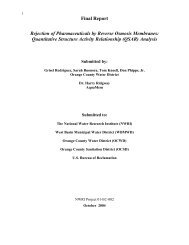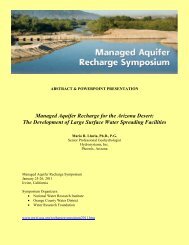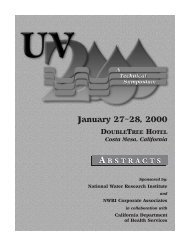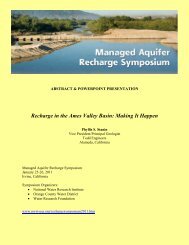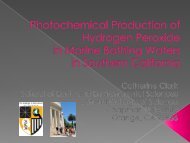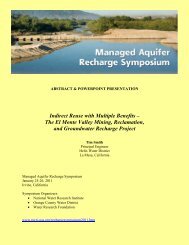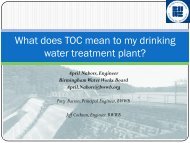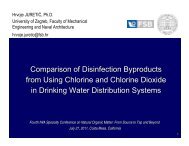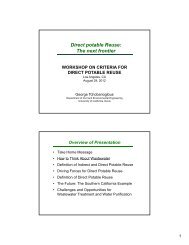RBF_Cover (for eps) - National Water Research Institute
RBF_Cover (for eps) - National Water Research Institute
RBF_Cover (for eps) - National Water Research Institute
You also want an ePaper? Increase the reach of your titles
YUMPU automatically turns print PDFs into web optimized ePapers that Google loves.
74<br />
When the hydraulic conductivity of the bed and bank are reduced to moderate values (see sets<br />
A-A and B-B in Ray et al., 2002), there is a significant attenuation of atrazine at the collector well<br />
caisson (Figure 5). It is clear that the transient effects call <strong>for</strong> the use of complex three-dimensional<br />
models to account <strong>for</strong> the spatial and temporal variability of streamlines. Based on hydraulic head<br />
measurements and water-quality observations, the calibration of flow and transport models is<br />
essential <strong>for</strong> an accurate description and prediction of the fate of individual or multiple chemicals.<br />
The current version of the standard MT3DMS code (Zheng and Wang, 1999) accounts <strong>for</strong> the<br />
transport of multiple species and a small range of basic reactions; however, <strong>for</strong> cases where<br />
chemical species are assumed to interact in a more complex manner, MT3DMS-based packages<br />
such as RT3D (Clement, 1997) or PHT3D (Prommer et al., 2003a), which account <strong>for</strong> a greater<br />
variety of biogeochemical processes, are available.<br />
Atrazine Concentration, µg/L<br />
4<br />
3<br />
2<br />
1<br />
0<br />
River water<br />
Caisson (set B-B)<br />
Caisson (set A-A)<br />
Multi-Species and Multi-Component Transport Modeling<br />
No reaction – filtrate<br />
With reaction – filtrate<br />
River water<br />
0 20 40 60 80 100<br />
Days Since Start of Simulation<br />
Figure 5. Atrazine transport from the river to the aquifer and the pumping well <strong>for</strong> a case<br />
with low permeability riverbed/bank (after Ray et al., 2002).<br />
In those scenarios where the reaction progress of a dissolved chemical strongly depends on<br />
the concentration of one or more other dissolved species, reactive multi-species models can<br />
typically provide a better process description. This is particularly important if models are used in a<br />
predictive mode. Furthermore, if water-quality changes are additionally affected by water-sediment<br />
interactions, such as mineral dissolution/precipitation and/or ion-exchange reactions, a reactive<br />
multi-component transport model might need to be applied to explain specific field observations.<br />
Multi-component models typically use an extensive reaction database. Until recently, those<br />
databases were (in most cases) confined to the definition of thermodynamic equilibrium reactions,<br />
which made those models only applicable to systems where (all) reactions proceed relatively fast in<br />
relation to groundwater flow velocity (local equilibrium assumption); however, in most of the<br />
recently published models, a wide range of different kinetic reactions and processes can be defined.<br />
Models with those capabilities can be used to study complex process interactions that lead to non-



